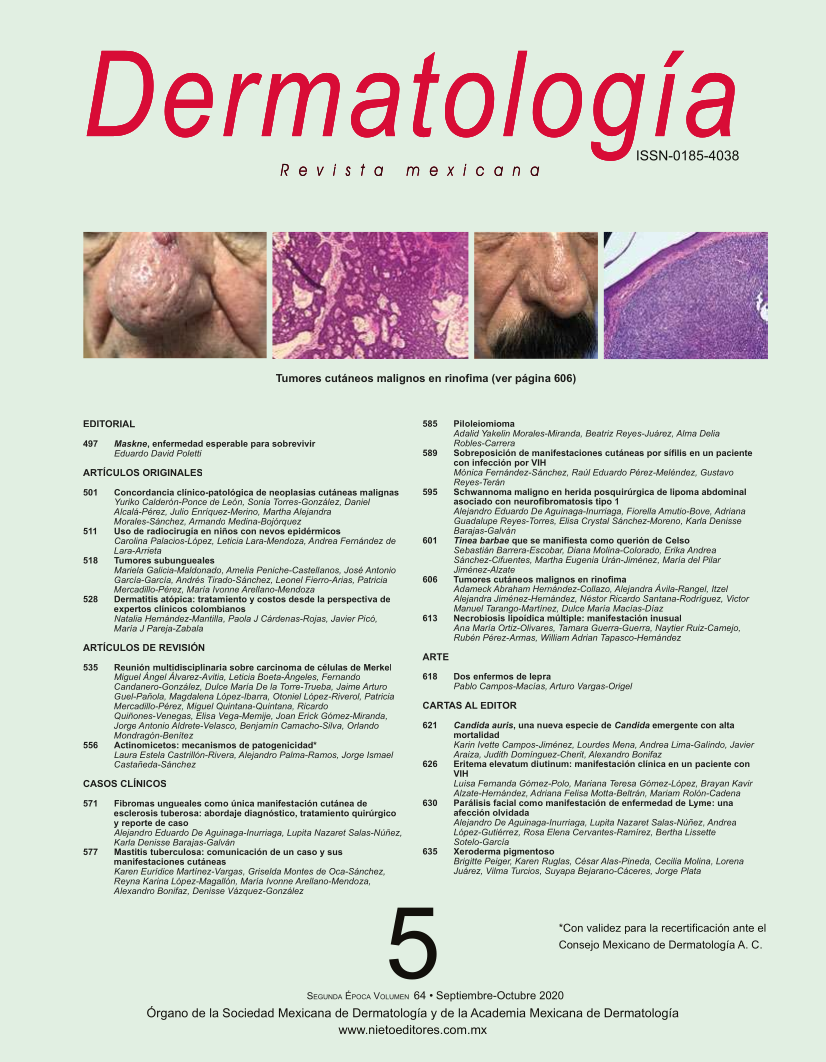Subungual tumors.
Dermatol Rev Mex. 2020; 64 (5): 518-527.
Mariela Galicia-Maldonado,1 Amelia Peniche-Castellanos,2 José Antonio García-García,3 Andrés Tirado-Sánchez,4 Leonel Fierro-Arias,5 Patricia Mercadillo-Pérez,6 María Ivonne Arellano-Mendoza7
1 Residente de Dermato-oncología y cirugía dermatológica.
2 Jefe del Servicio de Dermato-oncología y cirugía dermatológica.
3 Dirección de Educación y Capacitación en Salud.
4 Adscrito al Servicio de Dermatología.
5 Adscrito al Servicio de Dermato-oncología y cirugía dermatológica.
6 Jefe del Servicio de Dermatopatología.
7 Jefe del Servicio de Dermatología.
Hospital General de México Dr. Eduardo Liceaga, Ciudad de México.
Resumen
ANTECEDENTES: Los tumores ungueales se desarrollan entre la lámina ungueal y la falange distal, lo que condiciona que los síntomas y signos sean escasos y otro tipo de dermatosis que afectan las uñas puede confundir el diagnóstico.
OBJETIVOS: Determinar la prevalencia de los tumores subungueales con base en la revisión de expedientes clínicos en los últimos 10 años en el servicio de Dermato-oncología del Hospital General de México. Los objetivos específicos fueron determinar las características clínicas e histopatológicas de los tumores subungueales.
MATERIAL Y MÉTODO: Estudio observacional, descriptivo, retrospectivo, retrolectivo y transversal de los tumores subungueales en mayores de 18 años, de marzo de 2009 a noviembre de 2019 en el Hospital General de México Dr. Eduardo Liceaga.
RESULTADOS: Se observó que el tumor subungueal benigno más frecuente fue la exostosis subungueal y el tumor maligno más frecuente fue el melanoma subungueal. El género más afectado en ambos grupos fue el femenino, el promedio de edad fue de 43 años, el intervalo de tiempo de evolución fue de 1 a 240 meses. Ambos grupos de tumores se manifestaron con distrofia ungueal; sin embargo, los tumores benignos mostraron, además, dolor y sangrado.
CONCLUSIONES: Los tumores subungueales son un grupo de enfermedades; el género femenino es más afectado que el masculino, la edad de manifestación y tiempo de evolución son amplios, la mayor parte no se asocian con traumatismo previo y afectan más la mano no dominante y el pie derecho.
PALABRAS CLAVE: Tumores subungueales; melanoma; uña.
Abstract
BACKGROUND: Ungual tumors develop between the nail foil and the distal phalanx, conditioning that symptoms and signs are scarce, and another type of dermatosis affecting nails can confuse the diagnosis.
OBJECTIVES: To determine the prevalence of subungual tumors, based on the review of clinical records over the last 10 years in the Dermato-oncology department of the Hospital General de Mexico; the specific objectives were to determine the clinical and histopathological characteristics of subungual tumors.
MATERIAL AND METHOD: An observational, descriptive, retrospective, retrolective and transversal study of subungual tumors seen in 18 years, from March 2009 to November 2019 at the Hospital General de Mexico Dr. Eduardo Liceaga.
RESULTS: The study found that the most common benign subungual tumor was subungual exostosis, and the most common malignant tumor was subungual melanoma. The most affected genus in both groups was female, the average presentation age was 43 years, the time range of evolution was 1 to 240 months. Both groups of tumors manifested with nail dystrophy; however, benign tumors also had pain and bleeding.
CONCLUSIONS: Subungual tumors are a group of diseases in which the female gender is more affected than the male, have a broad age of presentation and time of evolution, most are not associated with previous trauma and affect the dominant hand and right foot.
KEYWORDS: Subungual tumors; Melanoma; Nail.

